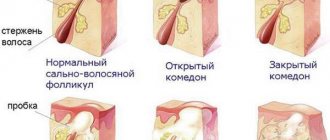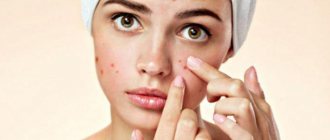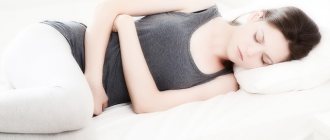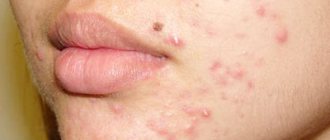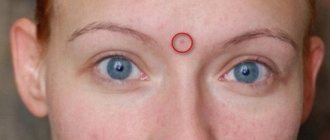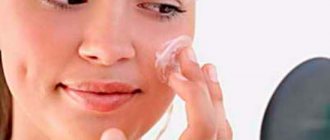Single rashes on the skin of the face are perceived as an annoying temporary defect. It is persistently masked with tonal means, and in the evening it is subjected to all sorts of disinfecting procedures. Having failed to achieve the disappearance of acne, we throw up our hands in bewilderment and say the stereotyped “apparently hormones...”. After which, some continue the pointless struggle, depleting the skin with cosmetics, while others - more conscious - go to the doctor. Test results are sometimes surprising, declaring the liver to be the cause of acne.
What functions does the liver perform?
There are many similarities between the structure and functions of the liver and skin:
- The skin is the largest organ by area, the liver is the second largest;
- A healthy liver is similar in structure to a sponge, like skin, covered with pores;
- The second factor is due to the performance of a general function - the removal of waste, unnecessary and harmful substances from the body.
This is not the only function that the described organ performs. You can live without a spleen, half a stomach, appendicitis, but the liver is an irreplaceable part. She is entrusted with responsibilities, without which it is impossible to ensure the vital functions of the body. It provides the following processes in the human body:
- Hematopoiesis and acts as a kind of blood depot, having the ability to retain up to 20% of its total volume.
- Detoxification, processing and retaining chemicals and toxic substances ingested through the digestive system or otherwise.
- Selection is a function that follows from the previous paragraph. The organ under discussion removes harmful and waste substances.
- The production of bile, which is responsible for the breakdown of fats.
- Synthesis of a complex of vitamins (A, group D, C and others), on which, among other things, the condition of the skin depends.
- Protein metabolism, insulin production and others.
Liver diseases directly or indirectly affect the functioning of all organs. Sometimes diseases are almost asymptomatic, causing no pain, but destroying the organ. Therefore, it is important to be able to consider changes that seem unrelated to the liver as signs of malfunctions in its functioning.
The skin eloquently signals problems in the functioning of this organ. A painful appearance, acne on the face, pimples, sagging, unnatural coloring of the epidermis indicates possible diseases and requires additional diagnosis and consultation with a doctor.
Localization of acne
You can guess in which organ system there is a problem if you know about the connection between facial areas and internal organs:
- Forehead. Single pimples reflect menstrual irregularities, significant rashes indicate ovarian pathology. Pimples on the transition line to the scalp are an exacerbation of gastritis or inflammation of the gallbladder.
- Pimples on the bridge of the nose, as well as red spots, indicate impaired liver function.
- In adolescence, pimples on the wings of the nose reflect the state of hormones, in older age - diseases of the digestive system and heart. Enlarged pores at the end of the nose indicate problems with the respiratory system.
- Cheeks indicate possible gallstones, biliary dyskinesia, and liver pathology.
- The chin area is an indicator of volumetric formations of the reproductive system organs - fibroids, cysts. Rashes can appear when the thyroid gland is not functioning properly. If there is chronic tonsillitis, the rashes are located closer to the lateral surfaces of the necks.
- Rashes on the lips indicate disturbances in the functioning of the gastrointestinal tract. Moreover, the condition of the stomach is reflected by the upper lip, and the condition of the intestines by the lower lip.
The connection between skin condition and liver function
How does skin become an indicator of liver condition? The epidermis, like the organ under discussion, is part of a system that removes substances from the body that are unsuitable for further use. These are toxins, poisons, and chemical elements that the body does not need. If, as a result of the disease, the excretory functions of the liver are inhibited, then these substances accumulate in the human body, like a time bomb. Trying to get rid of them, the body uses other systems. The kidneys, skin, and complex of digestive organs are not adapted for these purposes, and therefore suffer from the influence of factors unusual for them.
- a specific odor appears from the mouth;
- urine, feces, epidermis are painted in unnatural colors;
- the quality of sweat changes;
- rashes and acne appear on the skin.
To understand why acne on the face and body is a consequence of improper liver function, it is important to understand the very mechanism of the occurrence of rashes. The skin, like a sponge, is covered with pores, under which the ducts of the sebaceous glands are located. These glands produce a special substance called sebum. It is designed to soften the epidermis and maintain its water balance.
When the pores are open and clean, and the glands are functioning normally, the skin is protected, breathable and evenly moisturized. But as soon as the quality of sebum changes, it immediately clogs the pores, unable to remove it. As a result, blackheads (comedones) are formed. The same effect is caused by an increase in the amount of skin secretion and a decrease in pore capacity due to pollution. If bacteria enter such a nutrient medium, the comedones become inflamed, forming pimples (acne).
Trying to remove toxins that poison the body from the inside, the human body increases the load on the epidermis many times over. The skin cannot cope with it, it works in emergency mode, the pores become dirty. And the nonspecific composition of the secretion of the sebaceous glands additionally provokes allergic skin reactions in the form of rashes and redness.
If an unhealthy liver cannot cope with removing toxins, then the body tries to remove them in other ways, including through the skin. The amount of substances removed through the pores increases sharply. The new composition of sweat and sebum contaminates them, causing the appearance of pimples (acne).
Herbal infusions
You can reinforce therapeutic measures to cleanse the body with natural compounds that have choleretic properties.
These include rose hips, motherwort, valerian, and peppermint. However, you should not get too carried away with cleaning with medicinal plants; failure to comply with dosages or long-term use can lead to side effects.
Herbs are brewed one at a time or made into infusions and consumed like regular tea. A small spoon of plant or collection:
- pour a glass of boiling water;
- insist a little;
- strain and drink.
To improve the taste, you can add a couple of lemon slices and a large spoonful of honey, but only if you are not allergic to these products!
Decoctions should be consumed no more than twice a day. The average duration of the course should be no more than a month. Before starting herbal herbal therapy, it is strongly recommended to check for the presence of intolerance, since otherwise the patient will only aggravate the situation and the number of acne will increase.
Signs of liver disease that appear on the skin
Various factors provoke malfunctions in the liver, and each of them has its own impact on the condition of the skin.
- Hepatitis. A disease that most often affects the described organ. It destroys cells, which lose their ability to filter and store nutrients.
- Diabetes. The organ converts glucose into glycogen and stores it “until required.” Therefore, sugar levels directly affect the condition of this organ.
- Long-term use of medications. Antibiotics, antidepressants, anticonvulsants, drugs for the cardiovascular system and others increase the level of enzymes produced.
- Alcoholism. The liver removes substances harmful to it from the body. Among them is alcohol, which with constant exposure leads to alcoholic hepatitis and other organ dysfunctions.
In addition to these factors, in some cases, diseases of the described gland lead to:
- parasites that have settled in the body;
- improper diet;
- disturbances in emotional state;
- blood diseases.
On the skin, ailments of the organ under discussion manifest themselves in a wide variety of forms. And making a diagnosis based on the appearance of skin rashes is wrong. But if the following problems have been bothering you for a long time, then this is a reason to visit a doctor for examination:
- Yellowness of the skin indicates an excess of bilirubin.
- Multiple pimples indicate intoxication.
- Hives and redness indicate the inability to remove some chemical from the body.
- Acne and acne are the result of a decrease in the protective properties of the epidermis due to a lack of nutrients.
Changes in the appearance of the epidermis are signals from internal organs about the negative processes that occur in them. The liver makes its problems known through skin rashes, changes in pigmentation, and deterioration in the general condition of the epidermis. The same symptoms also occur with diseases of other organs, so only a doctor can make an accurate diagnosis.
Hepatoprotectors
To cleanse and start regenerative processes in the liver, the patient needs to take hepatoprotectors. Positive dynamics of the disease is observed when taking the following medications:
Heptral
A highly effective drug for protecting the liver, Heptral has antioxidant, restorative properties, and removes toxic substances from the body.
With a course of use, it is possible to improve liver function, cleanse and strengthen tissues.
The hepatoprotector is produced in the form of a solution or tablets, taken for two weeks, if necessary, the course of therapy is increased to a couple of months.
Heptral is considered a safe medication; it has a minimal list of contraindications, including only intolerance and the first two trimesters of pregnancy.
Liv 52
Liv 52 has a choleretic and hepatoprotective effect. The medicine is made on a plant basis and contains:
- chicory seeds;
- caper rhizome;
- Cassia seeds.
The pharmacy sells Liv 52 in tablet form. It is suitable for eliminating hepatitis associated with toxic effects, infectious processes, and antibiotic use. The duration of the course of treatment is determined by the severity of the disease, the intensity of the symptoms, and administration for the purpose of prevention is not excluded.
Essentiale forte
Essentiale Forte is based on phospholipids that cleanse the body, evacuate harmful substances, and restore the liver.
Indications include fatty degeneration of hepatocytes, cirrhosis, alcoholic lesions, and psoriasis.
To eliminate acne, Essentiale is continued for a long time; the drug is well tolerated by the body and does not cause negative reactions.
In rare cases, allergic reactions and the development of dyspeptic syndrome cannot be excluded. Symptoms do not require discontinuation of treatment.
Ovesol
Cleansing the body with Ovesol helps fight acne on the skin of the body and face. The dietary supplement contains the following components:
Ovesol cleanses the liver well, enriches the organ with essential microelements, and ensures rapid recovery. Thanks to successfully selected components, the dietary supplement promotes better excretion of bile.
Karsil
Another option for eliminating skin rashes is Karsil. Indications for use include cirrhosis of the liver, hepatitis, and biliary dyskinesia. The drug cleanses the filter organ and activates recovery processes.
How to prevent diseases
The liver is a complex organ that performs several functions at once. Its activity is cyclical and depends on the time of day and regime. To help this gland cope with the tasks assigned to it, follow simple rules.
- Review your diet. This organ does not like fatty, spicy, fried, smoked foods. Treat him with plant foods, preferably raw. If this option is completely unsuitable, then it is permissible to eat steamed vegetables. The epidermis will thank you for this step by reducing rashes and allergic reactions.
- Follow a diet that excludes sugar, proteins, canned food, and flour. Add fermented milk products, fish, and nuts to your diet. Sugar is an excellent food for microorganisms living on the skin, so reducing its amount is the prevention of blackheads, acne and blackheads.
- Burn fat through active sports. Aerobics, wrestling, swimming - it’s all the same. Choose what is closest to you, but take this load off your liver. This will also have a beneficial effect on the condition of the skin. Increased sweating helps remove toxins, and oxygenated blood is more likely to deliver beneficial substances to the surface of the skin.
- Eliminate or limit alcohol consumption. The liver is the first to suffer from this product and it bears the brunt of the impact. Losing strength to fight, it transfers powers to the skin, which does not have reserves to remove this poison and quickly becomes dehydrated, covered with spots, pimples, and deep ulcers (boils).
- Even if you eat right, it is important not to neglect regular liver cleansing. It is not difficult to purchase a choleretic preparation at the pharmacy, which is recommended to be taken according to the prescription indicated on the package. This measure will heal the organ by expelling stagnant bile and return the skin to its natural color.
- Vaccination is recognized as a preventive measure to prevent hepatitis. The first vaccination is given immediately after birth and almost always causes “infant jaundice” - the baby’s skin turns yellow, but this effect goes away after a few days. The following vaccines are administered according to the 0-1-6 schedule, which means the drug is administered one month after the first, and then six months later. For adults and people at risk, the vaccination procedure is determined by the doctor. Typically, the scheme is: 0-1-2-12.
Compliance with these conditions will improve not only the gland described. Together with it, the skin will also come into order, if it was previously revealed that the cause of acne is liver disease. The condition of the whole organism will improve, because the activity of this large biological filter affects every organ.
The appearance of the skin and the condition of the liver are directly related, since these organs perform one common function - removing toxins. Activities that have a positive effect on this gland also have a beneficial effect on the quality of the epidermis.
Preventing rashes
Diet plays an important role in eliminating acne. The basis of nutrition consists of foods rich in plant fibers. These are porridges, vegetables, raw and after heat treatment. Animal products are allowed: veal, chicken, turkey, rabbit. Industrially produced products are contraindicated: sausages, semi-finished meat products. Among dairy products, preference should be given to those with low fat content. Limit confectionery and other sweets, carbonated drinks, and sour juices.
Advice. Meals should be small, with a moderate amount of salt. It is imperative to maintain a drinking regime.
Eating fresh vegetables and fruits rich in vitamins A and C helps cleanse the skin of acne and improve the liver. Healthy lipids contain oils: olive, sesame, flaxseed and sunflower.
Personal hygiene is a necessary condition for treating acne. It is recommended to use hygiene cosmetics with a neutral pH value (from 5.5 to 6.5). Decorative cosmetics should be chosen with a minimum content of comedogenic components.
Recommendations from experts
If acne is stubborn, the dermatologist will prescribe antibiotics and retinoids orally. The endocrinologist recommends medications to improve hormonal levels and strengthen the immune system.
The main measure for the prevention of hepatitis A and B - vaccination - helps to avoid diseases and rashes associated with liver damage. Such protection against the most dangerous hepatitis C has not yet been created.
A combination of the antiviral drug Ribaverin with Interferon alpha is used, which enhances immune defense against infection. Although this treatment has contraindications and side effects, it allows you to avoid the chronic course of hepatitis C and reduce the risk of serious consequences.
Principles of treatment of liver diseases
If it was not possible to prevent liver disease, then it will be comforting to know that in the initial stages this unique organ, like the skin, is able to independently restore damaged areas. Therefore, timely treatment can improve this “filter” without consequences for it. The other side of the coin is that the liver fights the problem on its own for a long time and therefore the disease is asymptomatic. Only the skin systematically signals a problem with rashes and acne. It is important to pay attention to these signals and not to heal yourself, but to go to a dermatologist. A general and biochemical blood test can identify the problem, which will show the presence of inflammatory processes and the level of individual marker elements.
Suspecting a problem in the liver, the doctor will refer the patient for an ultrasound examination to confirm the preliminary diagnosis. In addition to this procedure, an MRI or CT will show a picture of the condition of the organ.
Drug treatment of liver problems is complicated by the fact that a weakened gland, which under normal conditions passes all medications through itself, is unable to fully accept medications to alleviate its own condition. At first, the condition of the skin worsens, pimples and blackheads, pigment spots and jaundice may intensify due to an even increased load on the epidermis.
Some diseases (fatty hepatosis, cirrhosis) cannot be cured with folk remedies, and drug treatment is prescribed by a doctor. With others, on the contrary, it is recommended to fight with herbs. Oats, immortelle, milk thistle, agrimony, rowan, and St. John's wort come to the rescue. Eating vegetables is effective: beets, carrots, tomatoes. Honey also promotes healing.
Treatment of certain diseases with hepatoprotectors on a natural basis is popular. These drugs stimulate the activity of healthy organ cells, protect them from the negative effects of chemical elements and other substances, reducing the burden on the “patient”.
Treatment for liver problems should only be prescribed by a doctor. Self-medication almost always leads to irreversible consequences in the organ, after which the unsatisfactory condition of the skin will seem the lesser of the evils. Skin rashes due to liver diseases are treated in parallel and disappear after completion of therapy.
The connection between hepatitis and the appearance of rashes
The yellowish color of the skin and mucous membranes of the eyes is a consequence of exposure to bilirubin that is not excreted by the liver. The formation of bluish spots on the body is associated with increased fragility of capillaries. With hepatitis, the production of proteins involved in the blood clotting process is disrupted.
What does the rash look like:
- Nodules are small, dense formations.
- Papules are pimples without a cavity inside.
- Pustules are blisters with liquid contents.
- Spots of various diameters.
- Liver plaques.
- Ulcers.
Acne due to hepatitis A
The disease in children usually occurs without external symptoms. Hepatitis A acne can appear in adults, but is less common than with other types of liver damage. The rash is similar to the blisters that occur with hives.
Acne due to hepatitis B
HBV viruses cause acute inflammation of the liver, which is manifested by symptoms of intoxication. Spots and pimples due to hepatitis B occur in approximately 5–10% of patients. Elements of the rash are located on the limbs and back and buttocks. The appearance of red dots indicates that the inflammatory process is also developing in the kidneys.
In most cases, complete recovery occurs. But sometimes hepatitis B becomes chronic. Immunodeficiency occurs, against which ulcers appear.
Acne due to hepatitis C
The HCV virus infection causes flu-like symptoms: loss of appetite, joint pain, fever, nausea. Hepatitis C can cause acne and other rashes. They are associated with constant itching, which intensifies at night. In 80% of all cases, chronic hepatitis develops and its inherent irreparable consequences. The HCV virus infection is called a “slow killer” for its ability to masquerade as other ailments for a long time.
Treatment of skin manifestations of liver disease
Rashes that are caused by liver problems are useless to treat without appropriate treatment for the source of the problem. The effect achieved by local cosmetic procedures is short-term and relapse will not take long to occur. But you can alleviate the skin manifestations of liver problems with the help of pharmaceutical cosmetics, or by turning to the healing properties of folk remedies.
- Don't forget to nourish, tone and cleanse your skin. Proper care will help to normalize oil content to a certain extent, gently cleanse the pores of sweat and deliver some useful substances from the outside, which the epidermis has not received since the onset of the disease. Don’t expect stunning results; if you have liver problems, the skin tends to become oily quickly and this problem cannot be overcome. Do not try to dry out the epidermis by frequent washing. This will not help, but will lead to the opposite result - even oilier skin;
- Take a diaphoretic. Increased sweating will help cleanse the pores and quickly remove toxins that poison the body and the skin itself. Excess of harmful substances provokes the appearance of inflamed acne of varying degrees of complexity. This can be a scattering of small acne, or severe types of carbuncles and boils. In the latter case, it will not be possible to remove them without medical intervention;
- Clay mask. If it is determined that the cause of the rash is still in the gland described, then it is recommended to make a mask with white clay every two to three days. It has the ability to draw toxins from the skin, which will come in handy in the situation described. Add a few drops of antiseptic tea oil to its composition if there are small pimples on the skin. This mask is also good to use at the final stages of treatment to accelerate the removal of remaining harmful substances;
- Immortelle decoction is recommended for use as a preventative against liver diseases and improves the condition of the skin, getting rid of acne. But even during the treatment period, the use of this herb in teas and lotions will alleviate the skin manifestations of the disease. Rosehip decoction has similar properties. Take it the same way: inside and outside;
- Do not squeeze pimples on your face and body! In case of liver diseases, their contents include many harmful microelements, which the body gets rid of through the skin. The spread of these substances over the surface of the epidermis will only increase the number of rashes. For the same reason, avoid scrubs and other cleansing procedures that injure the skin during the designated period.
- Traditional medicine recommends a decoction of chamomile with oats. Oats accelerate cell regeneration, which will help the epidermis recover quickly. But ingestion also activates the healing of liver cells. Thanks to its ability to regenerate, the liver is able to restore damaged cells if the disease is at the initial stage and until scars have formed on it.
Chamomile in the decoction plays the role of an antiseptic, relieving inflammation inside and out.
To relieve acne-damaged skin caused by liver disease, use topical products. This will help your skin cleanse its pores and add nutrients. Oral medications will have a complex effect on both the cause—the liver—and the effect—acne.
Use of probiotics
A patient with liver problems caused by taking antibiotics and other toxic drugs needs to restore the beneficial intestinal microflora. For this purpose, probiotics containing lactobacilli are prescribed. The substances help normalize the levels of beneficial bacteria, thereby improving the condition of tissues.
The drugs have no contraindications; adverse reactions are very rare. Linex, Acipol, Rioflora, Bifidumbacterin give good results. The course lasts at least one month.
Symptoms of inflammatory processes
If the pain comes on suddenly and you need instant relief from your symptoms before going to the doctor, experts give simple recommendations. How to determine whether your kidneys or back hurt? Most often, sharp, stabbing and acute pain indicates rheumatoid arthritis. Inflammatory processes in the kidneys manifest themselves differently. Carefully monitor your condition throughout the day. Thus, pyelonephritis may not be accompanied by severe pain in the lumbar region and may have hidden symptoms (deterioration of health, difficulty urinating, heaviness in the kidney area).
In acute inflammation, an increase in body temperature is often observed. This is accompanied by swelling in the face, legs and arms, as well as increased blood pressure. If you don't know how to distinguish back pain from kidney pain, then observe the sensations in a state of calm. With inflammation, heaviness in the lower back does not disappear even when lying down or while sleeping. If you wake up in the middle of the night and feel the same unpleasant symptoms, do not hesitate to visit a doctor before the disease becomes chronic. Do not self-prescribe diuretics. Typically, these drugs are effective only in complex therapy.
